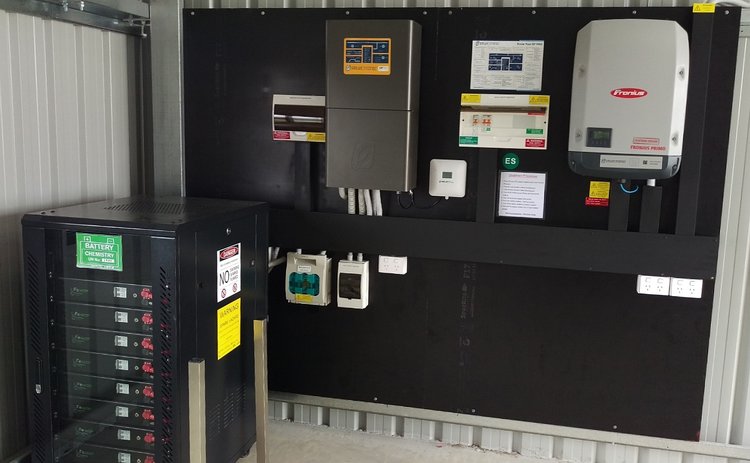A Basic Guide to Buying the Right Off-Grid Solar Inverter
If you've spent any time researching off-grid solar systems, you've probably heard about the importance solar inverters play in it. It's basically the system's brain, managing its power flow and controlling the two types of power - DC and AC. DC, also known as direct current, is the power harvested by the panels and stored in the batteries. This type of power can't be used by your appliances, which is exactly why you need a solar inverter to change it into AC, or alternating current, that can then be used to power your TV, lights, fridge and other household appliances. While there are also on-grid inverters, off-grid inverters are much different in what they do.
On-grid inverters take the DC power harvested from the panels, transform it into AC, then send that power to the grid for credit. They're much simpler and easier to wire, simply because on-grid solar systems feature two main components - the panels and the inverter itself. Rarely do on-grid solar systems incorporate a battery for storing extra power. Off-grid systems, on the other hand, need a battery in order to function. The solar panels send DC power into the batteries, and the inverter takes that power and creates AC power for your appliances, essentially working as a small power grid.
That being said, off-grid systems are much more complicated, as not only do they feature a battery, but also extra components such as a battery monitor, a charge controller and extra DC and AC circuit breakers. All of this makes off-grid systems more difficult to install and wire. Buying off-grid equipment also poses its own challenges, as there are many associated accessories, such as surge suppressors, breakers and enclosures, remote controls and battery monitors. Picking the right parts can be head-scratching, but not as head-scratching as picking the right inverter. Having said that, here are the most important things you'll have to consider when choosing an inverter.
The Size
The first thing you'll have to consider is how much power you'll need. Luckily, sizing off-grid inverters is quite straightforward, as long as you know what appliances you need to power. Basically, you add the wattage of all the appliances you'll be using at once. And while you probably won't be using everything at the same time, calculating the wattage of all the appliances can be an easy way to make sure you have a large enough inverter to satisfy your power needs. Additionally, you'll need to consider the voltage. Most appliances use anywhere between 220V and 240V. So for instance, if your fridge requires 700W, your lights require 300W and your TV requires 200W, all of this adds to 1200 watts, for which you'll want an inverter of at least 1500W, just to have a little extra wiggle-room.
Some of the most common inverter sizes are 600W sine wave inverter, 1000W, 1500W, 2000W, 2500W, 3000W, 4000W, etc. A 600W sine wave inverter, for instance, will be suitable for a small, part-time cabin that doesn't have many appliances, whereas a 4000W inverter will be suitable for an off-grid home with all the typical household appliances.
Type of Sine Wave
There are two types of sine wave inverters - pure and modified sine wave. You'll want a pure sine wave inverter, simply because they produce cleaner, safer power that can be used by all appliances in the typical household. These inverters provide higher quality power that's similar or even better than the power provided by the grid. Modified sine wave inverters are more affordable, but they also provide lower-quality power. If the type of power provided by the inverter isn't specified, you can quickly tell by looking at the total harmonic distortion rating. This indicates the power quality output and it should be listed on any specification sheet of any inverter manufactured by a quality inverter. To be on the safe side, you'll want an inverter with a total harmonic distortion of 5% or less.
Technical Specs That Matter
There are a few technical aspects that you need to consider in order to make sure you're getting the right inverter. First and foremost, you have to consider the efficiency, which is basically a measure from the batteries your inverter will deliver to your household when working in ideal conditions. A good peak efficiency inverter should be somewhere around 94-96%.
Additionally, you'll have to consider the inverter's surge capacity. The surge capacity refers to the amount of short-term overload the solar inverter can handle before it trips. Some appliances such as fridges or pumps require as much as 2 or 3 times the running power to start.
The temperature range the inverter can handle is also worth considering, especially if you intend on installing it in your garage or places that may end up being exposed to temperature extremes.
And lastly, consider the inverter's warranty. Most inverters come with 3 to 5 years warranty, with some manufacturers offering as many as 10 years.



This brand UTL Solar, India's most trusted brand for off grid solar inverter offers very good range of hybrid solar inverter which is very cost effective and best customer support and service.
ReplyDelete